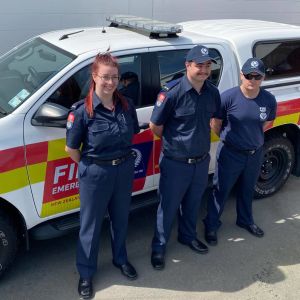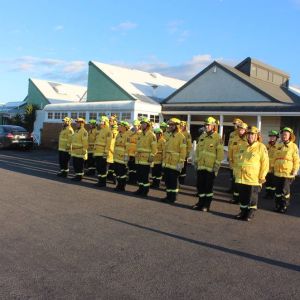Lower North Island Regional Rural Recruit Block Course makes firefighters of recruits

Working alongside our professional firefighters in Fire and Emergency New Zealand is a vast team of trained volunteers, ready to drop everything for a callout.
Deputy principal rural fire officer for the Whanganui District, Gavin Pryce, says they are called out predominantly for vegetation fires, which require specialist training.
"The skill set we mostly train in is in the vegetation firefighting component."
He says it differs enormously from structure fires.
"Different equipment used, different tactics employed: probably the only commonality is that we both use water.
"Throughout the country there are rural fire brigades that branch out into a little of the structure firefighting, some motor vehicle crashes, and most of us, in one way or another, help out with Civil Defence responses if there's a need. That's because a lot of rural fire forces or brigades are isolated. In some communities they are the only group of responders you can call upon."
Recently, a team of volunteers attended the Lower North Island Regional Rural Recruit Block Course, an annual exercise. This year it was in Hawera from October 4-10.
"It's a six and a half day course … it takes a recruit firefighter, who has very little or no experience, through all of the requirements we need for them to be able to ride the trucks and be a useful firefighter.
"It gives them all of the background situational awareness around fire safety, fire behaviour … just basics, but enough to be able to look after themselves, to be able to recognise situations when they are changing: differences in weather, wind direction and speed; working on slopes and different topography that can influence fire behaviour and understanding where they shouldn't be and where they should be, and ways to escape.
"We always teach them to have more than one escape route – their way in is not always their way out."
Gavin says the recruits also worked on techniques such as pump operation, working with hoses and using hand tools such as fire rakes, axes, grubbers and slashers. Such tools are used to cut fire breaks or containment lines to stop the fire spreading when there's no access to water.
"The whole course is based on nationally recognised unit standards so they come out with a certificate.
"They finish the course with a helicopter module, which includes the filling of monsoon buckets that the helicopters use to drop water on the fire."
The monsoon buckets are filled manually with a hose when the helicopter has no access to deep water. Gavin says they can fill a bucket in 12 seconds using a low pressure, big volume hose, and sometimes two at once if manpower permits. Depending on the lift capability of the helicopter, a monsoon bucket carries between 400 to 1000 litres of water.
"So they are taught how to do that and they are taught how to access helicopters in particular, because that's what we mostly use, as opposed to fixed wing, we use a rotary wing. So safe entry and exit from those machines and do's and don'ts around tail rotors and bits and pieces to look out for."
Included in the component is entry and exit while the helicopter is hovering.
"That's something we do out in the real world because we can't always land a helicopter on the side of a hill but that could be the best or only location to hop out and get us into the fire sometimes.
"The pilots enjoy doing that stuff. It's challenging for them and it's a little bit out of the norm."
Whanganui firefighters use Mid West Helicopters, based at Whanganui Airport.
Gavin says the course involved more than 50 hours of learning with a balance between classroom and practical work.
"They also had a couple of months up their sleeve to learn some theory based pre-course work which helped reinforce what they did on the course."
Gavin specialises in fire weather, so he attended for a day to work with the recruits and crew leaders.
He says about 30 students attended the course and there is no shortage of volunteers wanting to be rural firefighters.
"Right here, right now in Whanganui, we have a waiting list."
Gavin joined in 1996, starting as a volunteer with a small rural firefighting force just out of Whanganui. He has been in his present role for about four years.
Since all firefighting forces, rural, council and Fire Service amalgamated to become Fire and Emergency NZ, Gavin says he has seen many more opportunities for rural volunteers.
"More courses available, more access to resources, more opportunities for deployments in New Zealand, Australia and North America. There's a new tanker here they got a year ago: those sorts of things are huge benefits."
Three from Whanganui attended the block course: Jordan Conibear, Richard Jordan, Blair Gray (who attended for the last two days) and Lucy Brickley. Lucy is media co-ordinator at NZME Whanganui.
"I wanted to try something new, meet new people, and what's more exciting than facing a fire and trying to put it out?" says Lucy, who is now a rural volunteer firefighter and able to be called out to attend vegetation fires.
The course shifted her status from recruit to firefighter. She says a highlight was learning to use the hand tools.
Her favourite was the McLeod – a double edged long-handled tool with a rake one side and a sharp hoe the other.
"We were split into different crews and we had to dig a fire line through bush. My crew was Team Charlie."
She says the ground was all roots, peat and vegetation.
"We had to dig until we found mineral earth. It's the middle of the day, the sun's beating down, you're in all your gear, helmet on, it is hot! But I actually really enjoyed it."
The routine was something to get used to.
"Breakfast was at 6.30 every day … it becomes a community thing with everyone meeting up. We had parade at 7.30 where we had to be in full gear. Then we'd have the morning in the classroom, learning theory, doing assessments and recapping assessments from the day before.
"Then we'd do practical stuff, like having to go on the pumps, getting to spray some water around, portable dams …"
The helicopter component included a simulated engine failure, says Lucy.
"They'd sound a horn and drop almost right on top of you and you'd have to flatten yourself on the ground, and if you got covered in water you got covered in water. That was pretty cool. It was exciting."
Lucy says as a potential recruit she was encouraged to attend training sessions as an observer, then the three Whanganui volunteers were put through the paperwork system so they could be part of the October block course.
"So now Gavin has three more firefighters qualified for summer."
Lucy got permission from her employers before signing up as a firefighter because there will be callouts when she has to drop what she's doing and get to the fire station.
"I highly recommend people giving this a go."
As a female she says it can be intimidating walking into a male-dominated industry, but everyone was supportive and wanted her to succeed.
"They saw me as a person and wanted me to be part of that crew."
Paul Brooks
Whanganui Midweek 9/12/20


